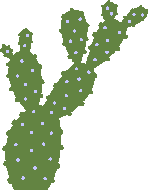 Managing Puncturevine - September 17, 2008 Jeff Schalau, Associate Agent, Agriculture & Natural Resources University of Arizona Cooperative Extension, Yavapai County Puncturevine (Tribulus terrestris) is a noxious weed sometimes called “goat head.” It is a summer annual that grows in disturbed areas and vacant lots and can be found throughout Arizona at elevations below 6,500 feet. Puncturevine is a low-growing, mat-forming plant with small leaflets that resemble small mesquite leaves. It has one-half inch wide yellow flowers and trailing stems that may reach one to six feet long in the summer. Hard spiny burs about one-half inch wide develop after the spiny fruits ripen. The spiny burs contain seeds. When the burs stick into shoes, tires, animals and other moving objects, they are dispersed into new areas where new populations can establish. Viable seeds can also lie dormant in soil for up to 20 years. Traditionally, landscape maintenance professionals and homeowners have used various herbicides to control puncture vine in commercial and residential landscapes. Pre-emergent herbicides containing oryzalin or trifluralin applied in spring (April 1) will kill seedlings as they germinate during summer. Selective herbicides can be used in situations where puncture vine has invaded lawn areas. When correctly applied, a selective herbicides, such as 2, 4-D, will kill puncture vine (and other broadleaf weeds) but not harm the grass. There are many selective and pre-emergent herbicide products available. Some of these are not labeled for use on puncture vine, so always read the product label before buying. Some non-chemical puncture vine control methods are also gaining popularity. These methods are especially welcome in areas such as schools, hospitals, and other public areas where herbicide use may not be acceptable. One such method is the use of propane weed burners. Propane burners can be especially effective in reducing the numbers of viable puncture vine seed left on the soil surface. I would also recommend discussing this method with your local fire department before purchasing a propane burner. Small populations of puncturevine can be controlled by hand pulling before or during flowering. This works best in moist soil. Once the burs begin to develop, you will definitely need heavy gloves for hand pulling. Learning how to identify young puncturevine seedlings is easy and essential to successful hand control (a photo is available on the web version of this column). In some situations, you may also reduce the puncture vine population through prevention. Prevention strategies include checking incoming seed sources such as tires, shoes, contaminated hay, and animals. Biocontrol (using one organism to manage another) has been very successful in reducing large puncturevine populations. There are two biocontrol organisms available for purchase. These are a seed-feeding weevil (Microlarinus lareynii) and a stem and crown mining weevil (Microlarinus lypriformis). These two insect species were collected from wild populations of puncture vine in its native range of surrounding the Mediterranean Sea in Europe and North Africa. The insects were also evaluated to determine if they could have negative effects on non-target plant species (plants other than puncture vine). Both biocontrol weevils have been successfully released in Arizona, Nevada, and California. However, they may not be present in your specific area because of isolation and/or small populations of puncture vines. Biocontrol insects will only persist in areas where the populations of the host plant are great enough to sustain them from year to year. Remember, biocontrol agents do not usually eliminate their food sources entirely. If they did this, they would not survive as a species over long periods of time. Introductions of the biocontrol weevils would make an excellent school project. Students would learn about insect biology, carrying capacity, predator/parasite interactions, and plant population monitoring while reducing their schoolyard population of puncturevine. It is too late this season to use biocontrol. So, learn to recognize the plant, remove and destroy as many seed laden plants as you can this year, and consider your best plan of attack for next year. Naming of companies or products is neither meant to imply endorsement by the author nor criticism of similar companies or products not mentioned. The University of Arizona Cooperative Extension has publications and information on gardening and pest control. If you have other gardening questions, call the Master Gardener line in the Cottonwood office at 646-9113 ext. 14 or E-mail us at cottonwoodmg@yahoo.com and be sure to include your address and phone number. Find past Backyard Gardener columns or submit column ideas at the Backyard Gardener web site: http://cals.arizona.edu/yavapai/anr/hort/byg/. Click here to see a photo of punturevine. |